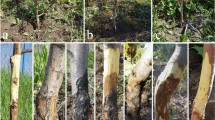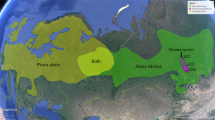Abstract
LEAF blights on maize are prevalent, particularly in the forest areas of Southern Nigeria. One of the commonest of these pathogens is Cochliobolus heterostrophus (Dreschl.) Dreschl., already recorded in West Africa in 1928 in Ghana1 and in 1933 in Nigeria2. The lesions develop in abundance on the leaves, from the lower ones upwards. A typically infected maize plant was taken at tasselling time and the area of the various leaves attacked by the fungus determined (Table 1).
This is a preview of subscription content, access via your institution
Access options
Subscribe to this journal
Receive 51 print issues and online access
$199.00 per year
only $3.90 per issue
Buy this article
- Purchase on Springer Link
- Instant access to full article PDF
Prices may be subject to local taxes which are calculated during checkout
Similar content being viewed by others
References
Bunting, R. H., Gold Coast Dept. Agric. Bull. 10 (Govt. Printer, Accra, 1928).
West, J., Kew Bull., 1 (1938).
Stanton, W. R., West African Maize Research Unit, Second Ann. Rep. (Moor Plantation, Ibadan, Nigeria, 1954).
Report on the Sample Census of Agriculture 1950/51 (Department of Statistics, Survey Department, Lagos, 1952).
Prest, A. R., and Stewart, I. G., The National Income of Nigeria 1950/51 (Univ. of Cambridge, Department of Applied Economics, 1951).
Author information
Authors and Affiliations
Rights and permissions
About this article
Cite this article
VAN EIJNATTEN, C. Susceptibility to Leaf Blight, caused by Cochliobolus heterostrophus, in Nigerian Varieties of Maize. Nature 191, 515–516 (1961). https://doi.org/10.1038/191515a0
Published:
Issue Date:
DOI: https://doi.org/10.1038/191515a0
This article is cited by
-
Development of southern corn leaf blight (SCLB) resistant and high-popping volume composite popcorn using phenotypic and marker-assisted selection (MAS)
Cereal Research Communications (2023)
-
Inheritance of resistance to Helminthosporium maydis blight in maize (Zea mays L.)
Theoretical and Applied Genetics (1984)
Comments
By submitting a comment you agree to abide by our Terms and Community Guidelines. If you find something abusive or that does not comply with our terms or guidelines please flag it as inappropriate.



